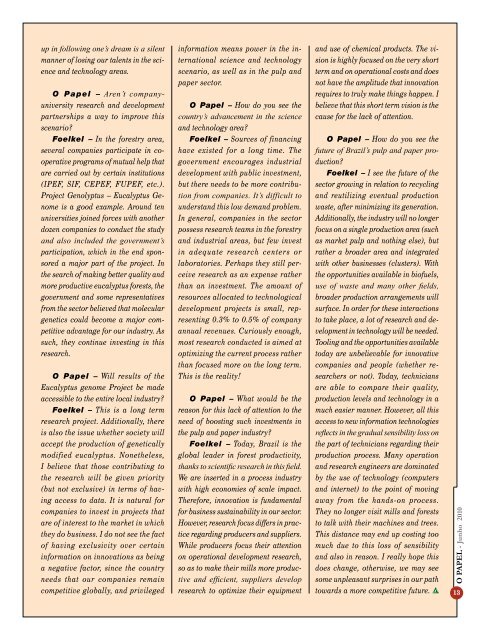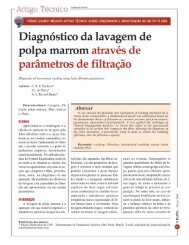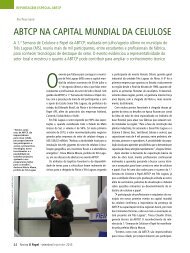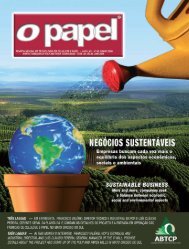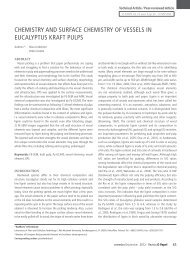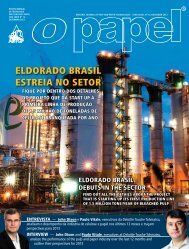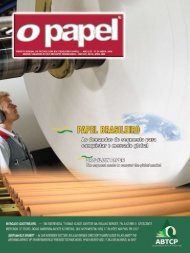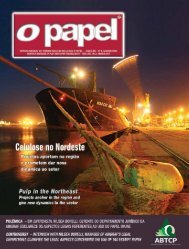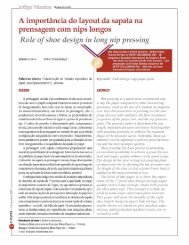Brasil na PulPaper - Revista O Papel
Brasil na PulPaper - Revista O Papel
Brasil na PulPaper - Revista O Papel
Create successful ePaper yourself
Turn your PDF publications into a flip-book with our unique Google optimized e-Paper software.
up in following one’s dream is a silentmanner of losing our talents in the scienceand technology areas.O <strong>Papel</strong> – Aren’t companyuniversityresearch and developmentpartnerships a way to improve thissce<strong>na</strong>rio?Foelkel – In the forestry area,several companies participate in cooperativeprograms of mutual help thatare carried out by certain institutions(IPEF, SIF, CEPEF, FUPEF, etc.).Project Genolyptus – Eucalyptus Genomeis a good example. Around tenuniversities joined forces with anotherdozen companies to conduct the studyand also included the government’sparticipation, which in the end sponsoreda major part of the project. Inthe search of making better quality andmore productive eucalyptus forests, thegovernment and some representativesfrom the sector believed that moleculargenetics could become a major competitiveadvantage for our industry. Assuch, they continue investing in thisresearch.O <strong>Papel</strong> – Will results of theEucalyptus genome Project be madeaccessible to the entire local industry?Foelkel – This is a long termresearch project. Additio<strong>na</strong>lly, thereis also the issue whether society willaccept the production of geneticallymodified eucalyptus. Nonetheless,I believe that those contributing tothe research will be given priority(but not exclusive) in terms of havingaccess to data. It is <strong>na</strong>tural forcompanies to invest in projects thatare of interest to the market in whichthey do business. I do not see the factof having exclusivity over certaininformation on innovations as beinga negative factor, since the countryneeds that our companies remaincompetitive globally, and privilegedinformation means power in the inter<strong>na</strong>tio<strong>na</strong>lscience and technologysce<strong>na</strong>rio, as well as in the pulp andpaper sector.O <strong>Papel</strong> – How do you see thecountry’s advancement in the scienceand technology area?Foelkel – Sources of fi<strong>na</strong>ncinghave existed for a long time. Thegovernment encourages industrialdevelopment with public investment,but there needs to be more contributionfrom companies. It’s difficult tounderstand this low demand problem.In general, companies in the sectorpossess research teams in the forestryand industrial areas, but few investin adequate research centers orlaboratories. Perhaps they still perceiveresearch as an expense ratherthan an investment. The amount ofresources allocated to technologicaldevelopment projects is small, representing0.3% to 0.5% of companyannual revenues. Curiously enough,most research conducted is aimed atoptimizing the current process ratherthan focused more on the long term.This is the reality!O <strong>Papel</strong> – What would be thereason for this lack of attention to theneed of boosting such investments inthe pulp and paper industry?Foelkel – Today, Brazil is theglobal leader in forest productivity,thanks to scientific research in this field.We are inserted in a process industrywith high economies of scale impact.Therefore, innovation is fundamentalfor business sustai<strong>na</strong>bility in our sector.However, research focus differs in practiceregarding producers and suppliers.While producers focus their attentionon operatio<strong>na</strong>l development research,so as to make their mills more productiveand efficient, suppliers developresearch to optimize their equipmentand use of chemical products. The visionis highly focused on the very shortterm and on operatio<strong>na</strong>l costs and doesnot have the amplitude that innovationrequires to truly make things happen. Ibelieve that this short term vision is thecause for the lack of attention.O <strong>Papel</strong> – How do you see thefuture of Brazil’s pulp and paper production?Foelkel – I see the future of thesector growing in relation to recyclingand reutilizing eventual productionwaste, after minimizing its generation.Additio<strong>na</strong>lly, the industry will no longerfocus on a single production area (suchas market pulp and nothing else), butrather a broader area and integratedwith other businesses (clusters). Withthe opportunities available in biofuels,use of waste and many other fields,broader production arrangements willsurface. In order for these interactionsto take place, a lot of research and developmentin technology will be needed.Tooling and the opportunities availabletoday are unbelievable for innovativecompanies and people (whether researchersor not). Today, techniciansare able to compare their quality,production levels and technology in amuch easier manner. However, all thisaccess to new information technologiesreflects in the gradual sensibility loss onthe part of technicians regarding theirproduction process. Many operatio<strong>na</strong>nd research engineers are domi<strong>na</strong>tedby the use of technology (computersand internet) to the point of movingaway from the hands-on process.They no longer visit mills and foreststo talk with their machines and trees.This distance may end up costing toomuch due to this loss of sensibilityand also in reason. I really hope thisdoes change, otherwise, we may seesome unpleasant surprises in our pathtowards a more competitive future.O PAPEL - Junho 201013


